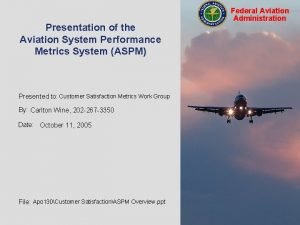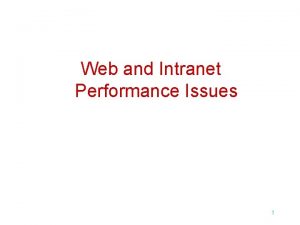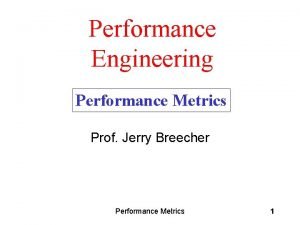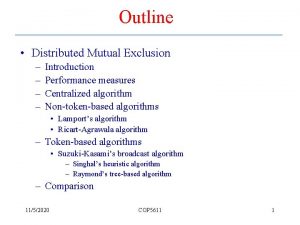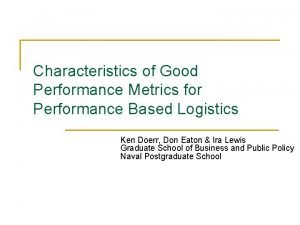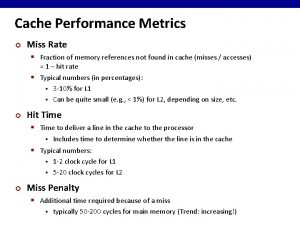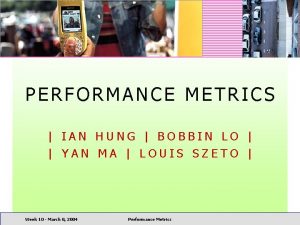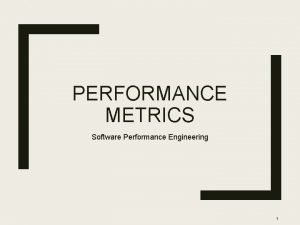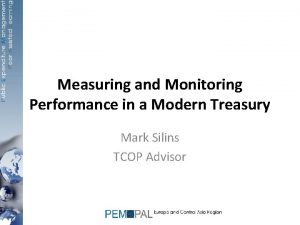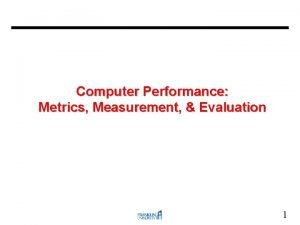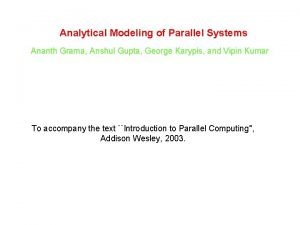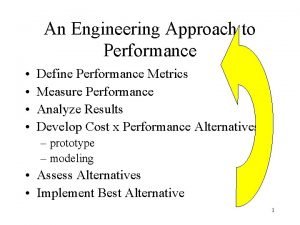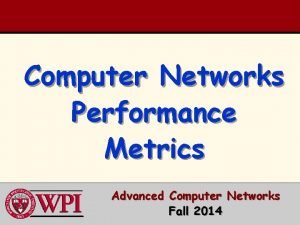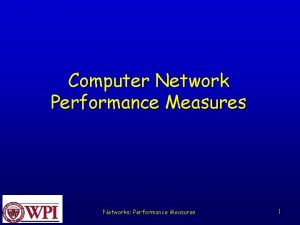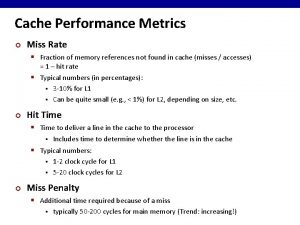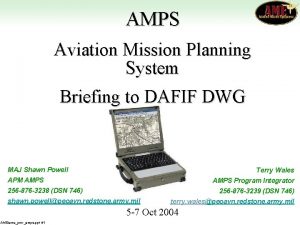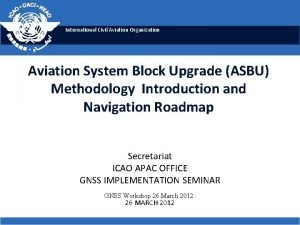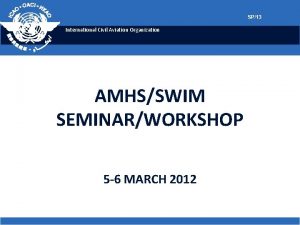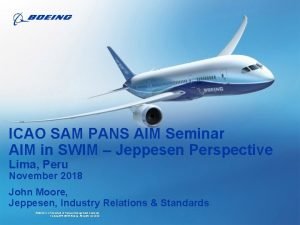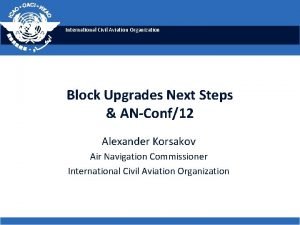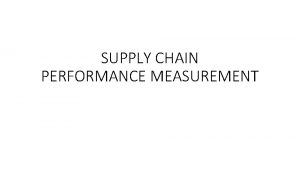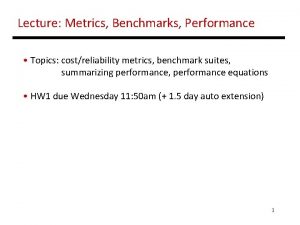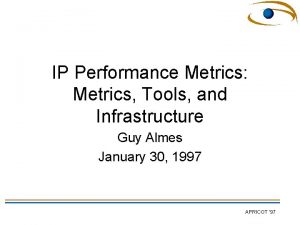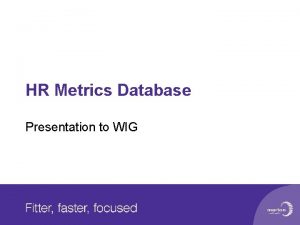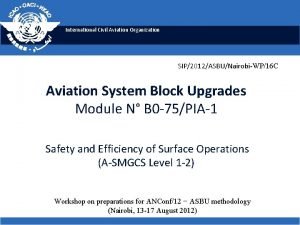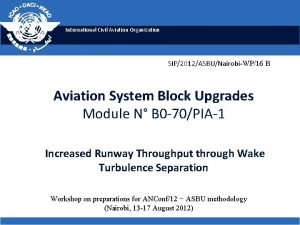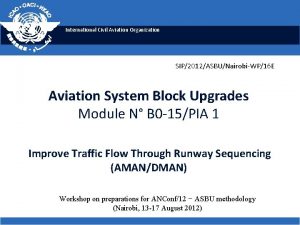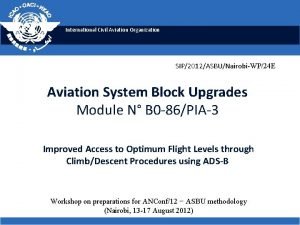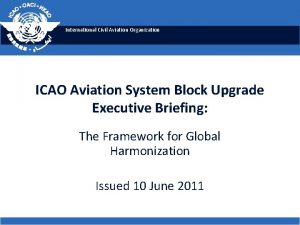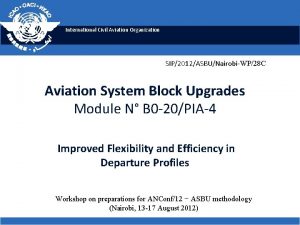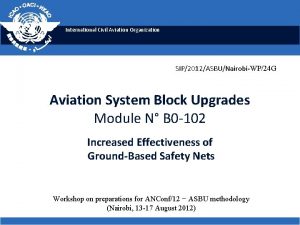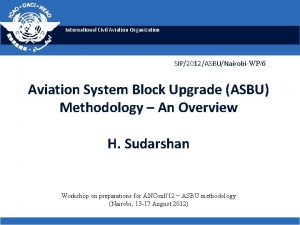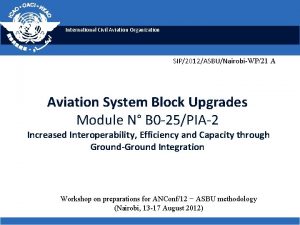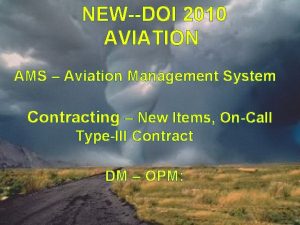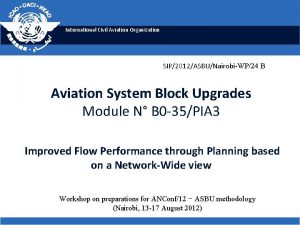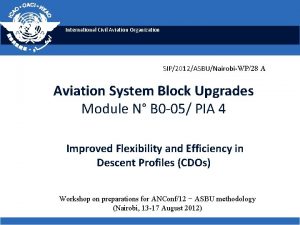Presentation of the Aviation System Performance Metrics System







































- Slides: 39

Presentation of the Aviation System Performance Metrics System (ASPM) Presented to: Customer Satisfaction Metrics Work Group By: Carlton Wine, 202 -267 -3350 Date: October 11, 2005 By: Tony Diana, 202 -267 -9942 Apo 130Customer SatisfactionASPM Overview. ppt File: September Date: 19, 2005 File: apo 130ASPMDocsASPM Presentation 05. ppt Federal Aviation Administration

ASPM and Other Reporting Systems ASQP ASPM OPSNET Data from 19 carriers provided monthly for all domestic flights Data available for all carriers at 75 airports Count of operations provided for towers, centers and TRACONS Actual out of the gate, off the runway, on the runway and in the gate time (OOOI) provided On a next day basis, OOOI data provided for 9 carriers (6 ASQP carriers plus Fed. Ex, UPS and Air Canada) Delays over 15 consecutive minutes (clock starts when flight comes under FAA control) are provided Causal information provided for flights arriving 15 minutes or more past schedule (available from June 2003) ASPM imports ASQP data when it is available, usually 25 days after the end of the month Delays are those that are attributable to the National Airspace System (NAS) and weather Percent on-time based on flights scheduled (counts cancelled and diversions as delayed) Percent on-time based on flights flown (cancelled flights and diversions not included) Causes of delays are provided (weather, volume, equipment, runway, other) Trends should be the same as ASPM or ASQP but count of delays and percent of operations delayed are not comparable Count of delays are assigned to the facility where the cause occurred not where the delay occurred Presentation of ASPM October 11, 2005 Federal Aviation Administration 2

ASPM Overview What is it? ñIntegrated database of air traffic operations, airline schedules, operations and delays, weather information, runway information, and related statistics. What is it used for? ñReporting and analysis of operating performance of the National Airspace System (NAS). Major Benefits: ñInternet interface to allow for quick analysis of large amount of operational data. ñSystem provides the capability to download data to individual analysts’ workstations for further study. Features: ñData are available from January 2000 to present for 55 airports. Data for additional 20 airports are available from October 2004 to present. ñActual traffic and airport information is confidential and access is restricted by password. ñData come from ARINC’s Out-Off-On-In (OOOI), Enhanced Traffic Management System (ETMS), US Department of Transportation’s Aviation’s Airline Service Quality Survey (ASQP), weather data, airport arrival and departure rates (15 -interval), airport runway configurations and cancellations. Presentation of ASPM October 11, 2005 Federal Aviation Administration 3

ASPM Overview ñArrival/departure rates and runway configuration data are available from January 1, 2000 to present. Delay information is available from January 1, 1998 to present. Data are Internetaccessible by 0700 each week day. ñOOOI data are available for American, Air Canada, Continental, Delta, Fed. Ex, Northwest, United Parcel Service and US Airways on a next day basis from ARINC. Air. Tran, Alaska, America West, American Eagle, ATA, Atlantic Southeast, Comair, Express. Jet, Frontier, Hawaiian, Independence, Jet. Blue, Skywest, and Southwest provide OOOI data through DOT On-Time system. Presentation of ASPM October 11, 2005 Federal Aviation Administration 4

ASPM Definitions On-Time = Departures/Arrivals less than 15 minutes late when compared to Schedule. Delayed = Departures/Arrivals 15 minutes or more late when compared to Schedule. Taxi-Out = Actual Taxi-Out Time minus Unimpeded Taxi-Out Time. Airborne = Actual Airborne Time minus Carrier Submitted Time Enroute. Taxi-In = Actual Taxi-In Time minus Unimpeded Taxi-In Time. Gate = Actual Gate Departure Time minus Scheduled Departure Time. Airport Departure = Actual Off Time minus (Scheduled Gate Departure Time plus Unimpeded Taxi-Out Time). Block = Actual Gate-to-Gate minus Scheduled Gate-to-Gate. Arrival = Actual Arrival Time minus Scheduled Time. Presentation of ASPM October 11, 2005 Federal Aviation Administration 5

ASPM Interface ASPM modules Presentation of ASPM October 11, 2005 Available operations and performance applications requiring log-in rights Federal Aviation Administration 6

ASPM Management Report Presentation of ASPM October 11, 2005 Federal Aviation Administration 7

ASPM Management Report Presentation of ASPM October 11, 2005 Federal Aviation Administration 8

ASPM Flash Reports Presentation of ASPM October 11, 2005 Federal Aviation Administration 9

ASPM Key Delay Indicators Presentation of ASPM October 11, 2005 Federal Aviation Administration 10

ASPM Airport Efficiency Presentation of ASPM October 11, 2005 Federal Aviation Administration 11

ASPM Airport Efficiency Presentation of ASPM October 11, 2005 Federal Aviation Administration 12

ASPM AAR/ADR Calculator Presentation of ASPM October 11, 2005 Federal Aviation Administration 13

ASPM Analysis Presentation of ASPM October 11, 2005 Federal Aviation Administration 14

ASPM Analysis Presentation of ASPM October 11, 2005 Federal Aviation Administration 15

ASPM Causality Presentation of ASPM October 11, 2005 Federal Aviation Administration 16

ASPM Causality Presentation of ASPM October 11, 2005 Federal Aviation Administration 17

ASPM Weather Factors Presentation of ASPM October 11, 2005 Federal Aviation Administration 18

ASPM Weather Factors Presentation of ASPM October 11, 2005 Federal Aviation Administration 19

ASPM Enroute Presentation of ASPM October 11, 2005 Federal Aviation Administration 20

ASPM Enroute Presentation of ASPM October 11, 2005 Federal Aviation Administration 21

ASPM Enroute Presentation of ASPM October 11, 2005 Federal Aviation Administration 22

ASPM Taxi Times Presentation of ASPM October 11, 2005 Federal Aviation Administration 23

ASPM Taxi Times Presentation of ASPM October 11, 2005 Federal Aviation Administration 24

ASPM Individual Flights Presentation of ASPM October 11, 2005 Federal Aviation Administration 25

ASPM Individual Flights Presentation of ASPM October 11, 2005 Federal Aviation Administration 26

ASPM Cancelled Flights Presentation of ASPM October 11, 2005 Federal Aviation Administration 27

ASPM Cancelled Flights Presentation of ASPM October 11, 2005 Federal Aviation Administration 28

ASPM Airport Download Presentation of ASPM October 11, 2005 Federal Aviation Administration 29

ASPM Data Reference Guide Presentation of ASPM October 11, 2005 Federal Aviation Administration 30

ASPM Data Reference Guide Presentation of ASPM October 11, 2005 Federal Aviation Administration 31

ASPM Information Page Presentation of ASPM October 11, 2005 Federal Aviation Administration 32

Terminal Area Forecast (TAF) Presentation of ASPM October 11, 2005 Federal Aviation Administration 33

Terminal Area Forecast (TAF) Presentation of ASPM October 11, 2005 Federal Aviation Administration 34

The Operations Network (OPSNET) Presentation of ASPM October 11, 2005 Federal Aviation Administration 35

The Operations Network (OPSNET) Presentation of ASPM October 11, 2005 Federal Aviation Administration 36

Flight Schedule Data System (FSDS) FSDS is an integrated flight information system based on the Official Airline Guide published schedule (OAG). FSDS allows to search flights by carrier type (US/foreign flag), flight type (domestic, foreign to US, US to foreign), user class (air carrier, commuter, all passengers and freight) and service type (piston, turbine, jet, helicopter). Presentation of ASPM October 11, 2005 Federal Aviation Administration 37

Enhanced Traffic Management System Counts (ETMSC) ETMSC allows to query ETMS records by airport or city pair and to arrange data by flight type (domestic, foreign, US to foreign, foreign to US), user class (air carrier, air taxi, freight, general aviation, military, other), equipment type (piston, turbine, jet, helicopter, other), equipment class (heavy, 757, large jets, medium, small, other), business jets, and regional jets. Presentation of ASPM October 11, 2005 Federal Aviation Administration 38

Airline Service Quality Performance (ASQP) ASQP is designed to query airline and airport performance data submitted every month by 20 carriers to US DOT Bureau of Transportation Statistics. ASQP enables to compare the carrier-reported causes of delay (late arriving aircraft, air carrier-related delays, security, National Air System, and extreme weather) with the facility-reported OPSNET types of delay (weather, terminal volume, center volume, runway, equipment, other). Presentation of ASPM October 11, 2005 Federal Aviation Administration 39
 Aviation
Aviation Intranet performance
Intranet performance Kpis template
Kpis template Enterprise architecture metrics
Enterprise architecture metrics Engineering performance metrics
Engineering performance metrics Singhal heuristic algorithm
Singhal heuristic algorithm Characteristics of good performance metrics
Characteristics of good performance metrics Cache performance metrics
Cache performance metrics Lo performance metrics
Lo performance metrics Software performance metrics
Software performance metrics Treasury kpi metrics
Treasury kpi metrics Introscope monitoring
Introscope monitoring Computer performance metrics
Computer performance metrics Performance metrics for parallel systems
Performance metrics for parallel systems Engineering performance metrics
Engineering performance metrics Chapter 2
Chapter 2 Strategic e-marketing and performance metrics
Strategic e-marketing and performance metrics Performance metrics in computer networks
Performance metrics in computer networks Router node
Router node Performance metrics in computer networks
Performance metrics in computer networks Cache performance metrics
Cache performance metrics Aviation mission planning software
Aviation mission planning software Asbu aviation system block upgrades
Asbu aviation system block upgrades Opmet briefing
Opmet briefing Aviation system block upgrades
Aviation system block upgrades Aviation system block upgrades
Aviation system block upgrades Design metrics of embedded system
Design metrics of embedded system Hình ảnh bộ gõ cơ thể búng tay
Hình ảnh bộ gõ cơ thể búng tay Ng-html
Ng-html Bổ thể
Bổ thể Tỉ lệ cơ thể trẻ em
Tỉ lệ cơ thể trẻ em Voi kéo gỗ như thế nào
Voi kéo gỗ như thế nào Chụp phim tư thế worms-breton
Chụp phim tư thế worms-breton Hát lên người ơi alleluia
Hát lên người ơi alleluia Các môn thể thao bắt đầu bằng tiếng bóng
Các môn thể thao bắt đầu bằng tiếng bóng Thế nào là hệ số cao nhất
Thế nào là hệ số cao nhất Các châu lục và đại dương trên thế giới
Các châu lục và đại dương trên thế giới Cong thức tính động năng
Cong thức tính động năng Trời xanh đây là của chúng ta thể thơ
Trời xanh đây là của chúng ta thể thơ Cách giải mật thư tọa độ
Cách giải mật thư tọa độ
